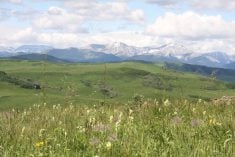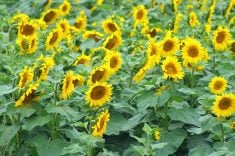Recent dry years on the Prairies seem to be a distant memory for many farmers gazing out at their muddy fields this spring.
Hardest hit by rain is southern Alberta, eastern Saskatchewan and southwestern Manitoba, said Bob Cormier, meteorologist with Environment Canada.
This week’s forecasts indicate rain slickers and boots will remain a dress requirement.
“We’re looking at a week of instability on the Prairies,” he said.
Flood watches and warnings were in effect in Alberta.
As of June 13, Alberta Environment issued flood warnings on the Oldman River downstream of the Oldman dam and Willow Creek, including the town of Claresholm.
Read Also

Gene editing digs deeper space in Canadian plant breeding
More Canadian research into crop variety development is incorporating gene editing, and one researcher notes that Canada’s regulatory approach to gene editing will help drive innovation
Last weekend, the South Saskatchewan River peaked around Medicine Hat, where a flood warning had been downgraded to a watch.
In contrast to the south, central Alberta through Grande Prairie and the Peace region remain on the dry side, said Cormier.
The driest is an area east of Red Deer to Coronation to west of Hanna, where rainfall is about 60-80 percent of normal. A forecast for rain showers will help those areas in central Alberta.
“Instead of broad areas of dryness across central and northwestern Alberta, we will be looking at a little more patchy dryness,” said Cormier.
Areas south of the Red Deer River remain soggy, with Pincher Creek, Okotoks and High River hardest hit by rain, said Erin Gregg of Alberta Environment.
“Some areas saw as much as 220 millimetres over four days,” she said.
Compared with the 1995 flood, this one has affected a broader land base, said Gregg.
Phil Thomas, senior agri-coach with AgriTrend Agrology, said the rain is welcome and flooding short-lived in once dry areas like Taber.
“The fields were quite dry and are able to absorb the water,” he said.
It is a different story in much of Manitoba and Saskatchewan, where plants already sitting in water cannot absorb more. While the excess water will damage some crops, it will greatly benefit others.
“If we start getting some reasonable growing conditions, the plants have a great capacity to recover,” said Thomas.
Saskatchewan is experiencing average to above average rainfall this spring. Kindersley, Rosetown and Outlook are saturated, with rainfall at 150-200 percent of normal.
A similar abundance of precipitation is reported at Hudson Bay, Melville, Weyburn and Estevan.
Karen Hill of Saskatchewan Crop Insurance said the Estevan office has received several inquiries and claims about unseeded acres and crop insurance deadlines. Farmers must seed by June 20 or file a claim on unseeded acres by June 25.
“If we get a nice week of good weather, it will make a difference,” said Hill.
There are concerns that more rain in the Alberta forecast this week will lead to more flooding of areas downstream of Lake Diefenbaker, said Martin Grajczyk, senior hydrologist with the Saskatchewan Watershed Authority.
“The basin is already wet and Lake Diefenbaker is full, so the potential is there for another significant event,” he said. “We have a lot less ability to use Lake Diefenbaker to reduce the flows.”
Grajczyk said the best case scenario would be for light sporadic rains as opposed to heavy rains in the mountains.
Rising water levels have already flooded pastures, wiped out floodplain crops and forced irrigators to move their pumps in areas near the provincial border to Cabri, Leader and Lancer.
Concerns over the higher water levels flooding nesting sites for the endangered piping plover had groups scrambling to save eggs last week.
Water levels downstream of Diefenbaker Lake are sitting one metre lower than in 1995.














